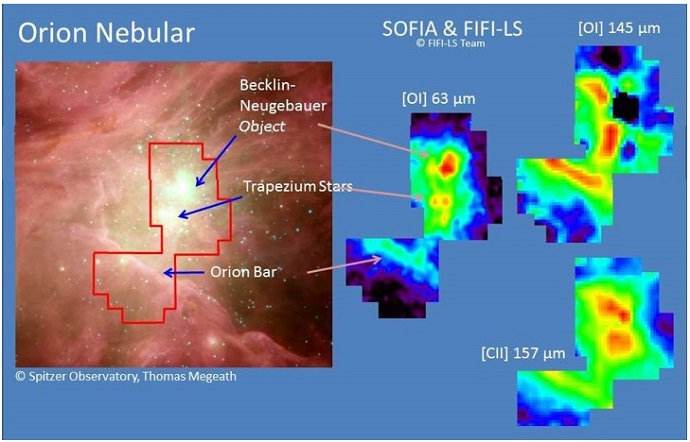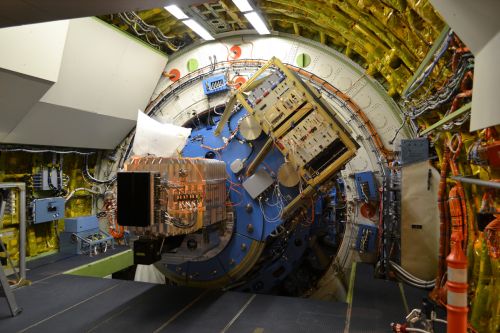28. April 2014
On its first scientific mission the far-infrared spectrometer FIFI-LS (Field-Imaging Far-Infrared Line Spectrometer) developed by a team led by the University of Stuttgart has explored the prominent star-forming region of the Orion Nebula. The instrument was flown on board the airborne observatory known as SOFIA (Stratospheric Observatory For Infrared Astronomy), a joint program of the National Aeronautics and Space Administration (NASA) and the German Aerospace Centre (DLR).
FIFI-LS was built at the University of Stuttgart's Institute of Space Systems (IRS) under the leadership of Alfred Krabbe. In November 2014, the instrument was shipped to NASA's Palmdale, California, facility to be prepared for operations on board SOFIA. Additionally the German SOFIA Institute (DSI) of the University of Stuttgart coordinates the operation of the flying observatory on behalf of the German partner.
Cooling of the gas is a requirement for star formation
The Orion Nebula is located about 1,300 light years from Earth, in the Milky Way Galaxy. This area of the sky is of high scientific interest, because it is one of the most active star-forming regions in our galaxy. Using FIFI-LS, astronomers want to investigate the Becklin-Neugebauer (BN) object, which is a molecular cloud that hosts young stars as well as dense gas which is still forming new stars.
A main requirement for this process is, that the “warm” gas in this region will cool down from about 100 K to about 10 K – only then the pressure inside the cloud drops and the gas density increases sufficiently enough in order to build stars. Elements like oxygen and carbon can drive this cooling process by emitting thermal energy from the inside of the cloud to the outside.

Fig. 1: The Becklin-Neugebauer object, the Trapezium stars and the bar of the Orion Nebular observed with FIFI-LS at the wave length of 63 µm, 145 µm and 157 µm corresponding to prominent lines of neutral Oxygen [OI] an ionized Carbon [CII] (right; copyright: FIFI-LS Team). Left: Spitzer image of the Orion Nebular (red: 8 µm, orange: 5.8 µm, green: 4.5 µm, blue: 3.6 µm; copyright: Thomas Megeath). The red contours indicate the position of the observing mosaics.
Leslie Looney, from University of Illinois and principal investigator for the Orion observations, will try to find out how these cooling processes work in detail. “Oxygen and carbon emit a considerable amount of cloud’s thermal energy at particular wave length, which we can monitor in a superb way with FIFI-LS,” said Looney. Currently SOFIA is the only observatory that can detect cosmic radiation at these far-infrared wavelengths.
In parallel to the cooling, the hot and young Trapezium stars of Orion heat the gas cloud. When this warmed-up and ionized gas hits cooler gas, it forms a shock front like the Orion bar. From the strength and the spatial distribution of the [OI] 63, 145 µm and [CII] 157 µm lines, Leslie Looney can investigate the actual relation between the cooling and the heating mechanisms. For example [CII] 157 µm could not be observed with any other observatory before. “The unique aspect of the FIFIU-LS data is the size of the map at this resolution," the astronomer summarizes.
Astronomer and instrument builder Alfred Krabbe from IRS is also very glad: “I am really happy that FIFI-LS cooperated in such a great way with the SOFIA observatory and that we can now provide a new scientific instrument to the astronomical community. For the next observing cycle that will start in spring 2015, the team plans to do more observations on Orion in order to complete the now existing charts.













